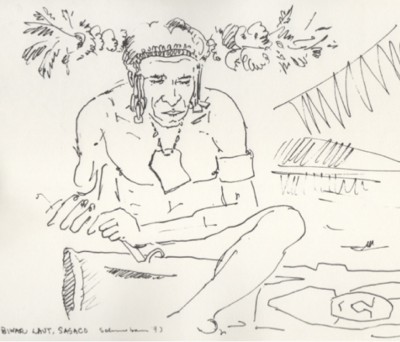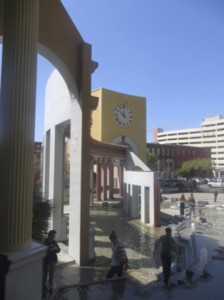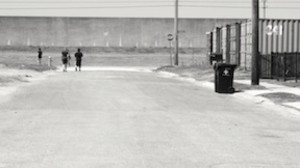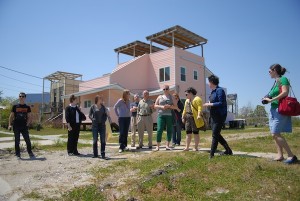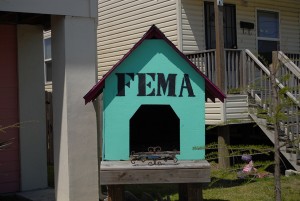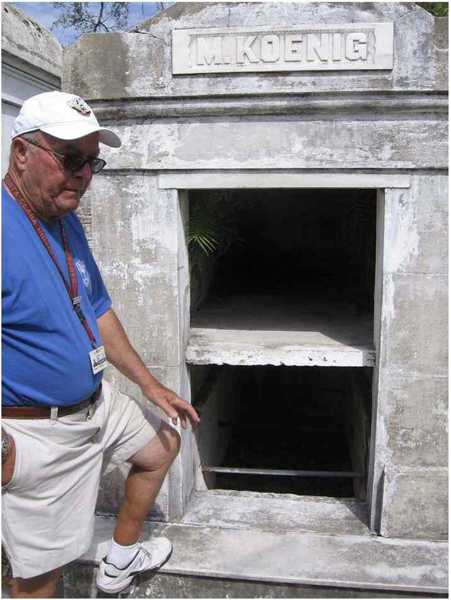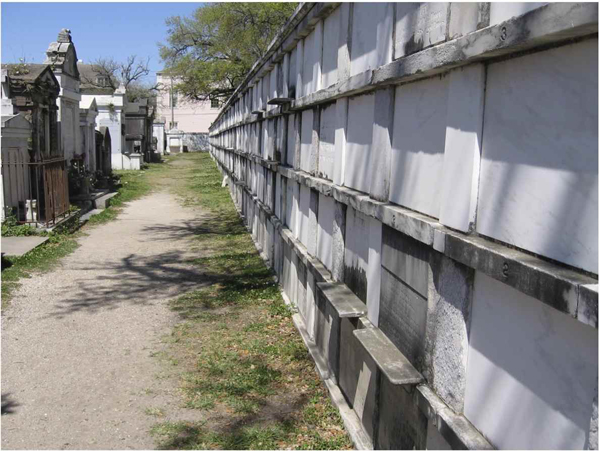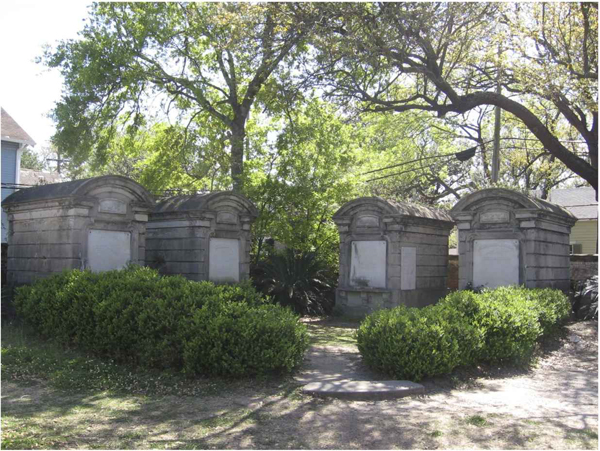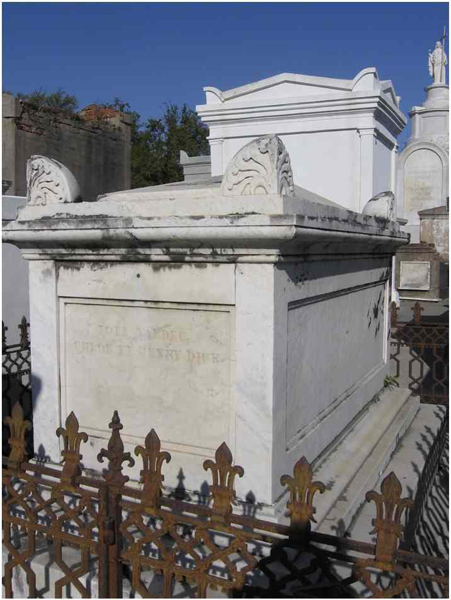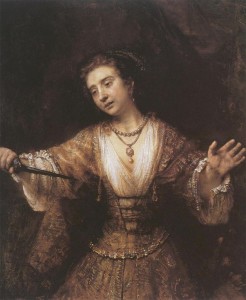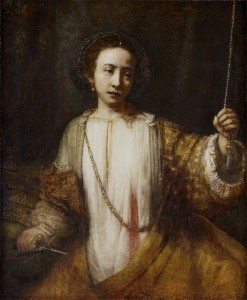Gretchen Burau is the Curator for the exhibition “Among the Asmat: The Schneebaum Perspective,” on view in the Gallery of the Anderson Student Center from September 4 to December 20, 2013. Mrs. Burau is the third graduate student to develop an exhibition for the American Museum of Asmat Art at the University of St. Thomas.
Before applying to St. Thomas I was unfamiliar with Asmat, having spent most of my academic career focused on Western art. After learning about the AMAA@UST’s extensive collection of Asmat Art, I decided to enroll in Dr. Julie Risser’s “Presenting Pacific Collections” course in Spring 2012. It was my first semester at St. Thomas and I was thrilled to be exposed not only to Asmat culture and art, but also individuals who aided in the preservation and commissioning of many objects now owned by the AMAA.
While researching for my final paper, I came across the work of artist and anthropologist Tobias Schneebaum, who first came to Asmat in summer 1973. It was during this time that he became involved with the Catholic mission and was introduced to Bishop Alphonse Sowada and Father Frank Trenkenschuh. Through this encounter, Schneebaum came to live and work in Asmat, eventually becoming the Assistant Curator of the Asmat Museum of Culture and Progress in Agats, Indonesia. One of Schneebaum’s finest contributions to the museum can be found in the skillfully executed drawings he made for Asmat Images, published in 1985. His illustrations were among the first published documentations of Asmat art and were instrumental in making the objects accessible to interested individuals who might not have had direct access to the art.
Through these drawings, Schneebaum would gain a detailed understanding of repeated imagery and was eventually able to decipher specific symbols and their meanings. Consequentially, he formed connections that helped tie certain villages and specific artists to their art, which was carefully recorded for the museum. The importance of the images has increased with time, as many of the cataloged pieces were made for ceremonial purposes and were not designed to endure after fulfilling their ritualistic tasks. As the years passed, many of these artifacts have deteriorated due to insects and the harsh jungle climate. Thankfully, Schneebaum’s drawings remain to attest to a distinctive art style made by a culture that today is rapidly changing.
Beside drawings, Schneebaum wrote several books, including Where the Spirits Dwell, highlighting his time in Asmat. His autobiographies were written with an artist’s sensibility, as shown in Secret Places: My Life in New York and New Guinea, where Schneebaum recorded:
Asmat bewitches me.
I often feel possessed there, but what it is that possesses me is unclear. The forest churns up my insides when I am in the midst of immense trees in soggy soil, vines, and plant life that exude odors of decay. The forest continually draws me into conjuring up dreams of living naked, hunting wild boar and cassowary, birds and possum, and spending days in blinds awaiting whatever animal would come, killing it, skinning it, roasting it, eating it.
At times when traveling with no one but my paddlers, I sit in the canoe or lie down on my pandanus mat in the men’s house and allow my mind to wander at will. I am impressionable: I am a million miles or more away. I am on some star of Orion or perhaps it is Sirius, brightest of them all. Perhaps I become one of the daughters of Atlas in the cluster of the Pleiades, or I am in some distant nebula, hurling myself headlong into the Void, through the night sky, a meteorite of myself landing easily on a star.
Throughout my life, I have been searching for a way to connect with other human beings. Suddenly, I find myself in a forest among the Asmat, living in their world of spirits, where I lose my insecurities and am content.
What brought me to this stage in the history of my life? Where did I go right? How did I finally choose a path out of oblivion, the path itself so marvelous to behold? I would not change that path even if it were possible to do so. (1)
Because of his tireless efforts, many museums, including the American Museum of Asmat Art @ UST and The Metropolitan Museum of Art have more diverse Asmat collections, with rare objects not to be found elsewhere. While traveling, Schneebaum was careful to record pertinent information: “I wrote in my journal several times a day; I put down everything I could remember of the trip from Agats and began taking notes on whatever I saw in the house: the sago bowls of wood and leaf in the racks, the digging sticks, the drums and spears and bows and arrows. I recorded the way the house was constructed, the number of adults and children; I made a plan of the fireplaces, with the names of those who sat and slept there, and I tried to make out how the food was divided, a complex subject I was never able to understand.”(2)
As a practicing artist, I had a natural affinity for Schneebaum’s drawings and observations. His work provided an avenue for me to access Asmat art and after completing Dr. Risser’s course, I was curious to learn more about the culture. I applied for the Assistant Curator assistantship at the AMAA and was fortunate to receive the position, quickly going to work on the fall 2012 exhibition, “Building the Collection: Recent Gifts and Purchases.” Having previously curated two-dimensional art exhibitions, this experience exposed me to sculptural objects and the challenges related to their mounting, transportation, and presentation.
As the academic year progressed, I assisted with Rachel Simmon’s exhibition “Wowipitsj: Man, Myth, Legend.” While working on these two shows, I continued to research Tobias Schneebaum and discovered that the University of Minnesota’s Jean-Nickolaus Tretter Collection houses his personal papers. Purchased from Schneebaum by University Libraries in 2004, the collection contains 33 boxes of personal correspondence, illustrations, and other materials related to various aspects of Asmat Art. Most notably, the collection contains a drawing Schneebaum made of Amandos Amonos, the main carver of the wuramon or soulship owned by the AMAA@UST.
These curatorial experiences combined with academic research led me to propose an exhibition of AMAA@UST art objects, illustrations, text, and video related to Schneebaum’s time in Asmat. “Among the Asmat: The Schneebaum Perspective” is a comprehensive showing of AMAA@UST art related to the work of Tobias Schneebaum. Arguably the most ambitious Asmat exhibition to be shown in the Gallery, it features twelve shields, two large carved crocodiles and many other objects that have not previously been on view at the University of St. Thomas.
I plan to use the Asmat-related information and experiences I have acquired over the past two years to prepare for my final qualifying paper in the M.A. program. Recently I contacted the Metropolitan Museum of Art, which has a Schneebaum archive that includes his personal documents and art objects. I hope to travel to New York during the next academic year to do research for my final research project and to provide the AMAA@UST with additional materials related to the Asmat.
NOTES
(1) Tobias Schneebaum, Secret Places: My Life in New York and New Guinea (Madison: University of Wisconsin Press, 2000), 3.
(2) Tobias Schneebaum, Where the Spirits Dwell (New York: Grove Press, 1988), 39.


